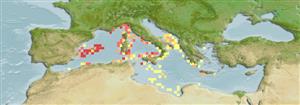>
Gobiiformes (Gobies) >
Gobiidae (Gobies) > Gobionellinae
Etymology: Buenia: Taken from Odon de Buen y del Cos, politician and Spanish naturalist; 1863-1945; lombartei: Named for Dr. Antoni Lombarte, researcher of the Institut de Ciències del Mar-CSIC, Barcelona.
Eponymy: Don Fernando de Buen y Lozano (1895–1962) (See DeBuen & also see Odón de Buen) Dr Antoni Lombarte is an evolutionary marine biologist and ecologist. [...] (Ref. 128868), visit book page.
Environment: milieu / climate zone / intervalo de profundidade / distribution range
Ecologia
marinhas demersal; intervalo de profundidade 343 - 375 m (Ref. 117412). Subtropical; 13°C - 13°C (Ref. 117412)
Mediterranean: Spain.
Tamanho / Peso / Idade
Maturidade: Lm ? range ? - ? cm
Max length : 2.8 cm SL macho/indeterminado; (Ref. 117412); 2.6 cm SL (female)
Descrição breve
Chaves de identificação | Morfologia | Morfometria
Espinhos dorsais (total) : 7; Raios dorsais moles (total) : 9; Espinhos anais: 1; Raios anais moles: 7 - 8. This species is distinguished by the following characters: the anterior oculoscapular canal is semi-closed with pores ?, ?, ?, ?, ? and additional pores and open furrows; (2) suborbital row c of 6 papillae; A I, 7-8; LL 25-27; TR 6; P 18; D1 II, with the longest spine of D1, backwards reaching to D2 middle in males when folded down, in females not reaching D2 I; pelvic disc anterior membrane reduced to less than 1/6 of spinous ray in midline depth; well developed tongue bilobed; head length 33.1-35.0 of SL; eye 32.9-33.5% of head length; anal fin base 11.7-12.2% of SL; pelvic to anus 19.4-20.4% of SL; snout 72.1-75.0% of eye diameter; pectoral fin 20.2% of SL; cheek depth 15.4-15.7% of head length; colour when fresh reduced to rarely scattered yellow dots and miniature melanophores densely distributed on head and body, only forming three small marks visible at lateral midline; colour when preserved reduced to scattered miniature melanophores on head and body, forming only three small marks visible at lateral midline (Ref. 117412).
Body shape (shape guide): elongated; Cross section: oval.
Life cycle and mating behavior
Maturidade | Reprodução | Desova | Ovos | Fecundidade | Larvas
Kovačić, M., F. Ordines and U.K. Schliewen, 2018. A new species of Buenia (Perciformes: Gobiidae) from the western Mediterranean slope bottoms, the redescription of Buenia jeffreysi and the first Balearic record of Buenia affinis. Zootaxa 4392(2). (Ref. 117412)
Categoria na Lista Vermelha da IUCN (Ref. 130435: Version 2025-1)
Ameaça para o homem
Harmless
Utilização humana
Ferramentas
Relatórios especiais
Descarregue XML
Fontes da internet
Estimates based on models
Phylogenetic diversity index (Ref.
82804): PD
50 = 0.5625 [Uniqueness, from 0.5 = low to 2.0 = high].
Bayesian length-weight: a=0.00724 (0.00338 - 0.01553), b=3.05 (2.87 - 3.23), in cm total length, based on LWR estimates for this (Sub)family-body shape (Ref.
93245).
Nível Trófico (Ref.
69278): 3.1 ±0.5 se; based on size and trophs of closest relatives
Resiliência (Ref.
120179): Elevada, tempo mínimo de duplicação da população menor que 15 meses (Preliminary K or Fecundity.).
Fishing Vulnerability (Ref.
59153): Low vulnerability (10 of 100).
🛈
